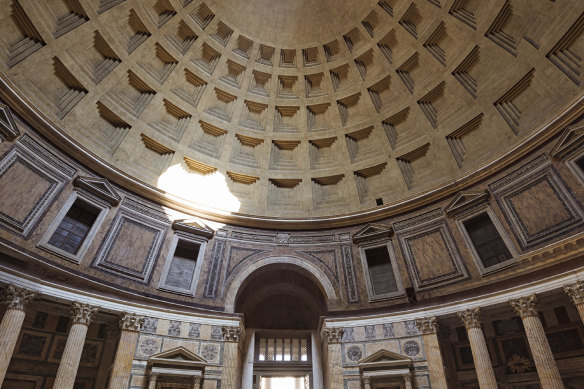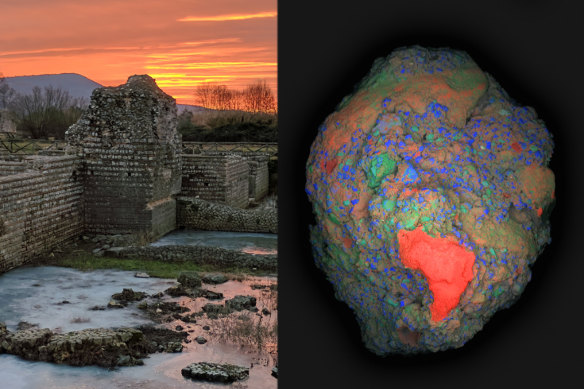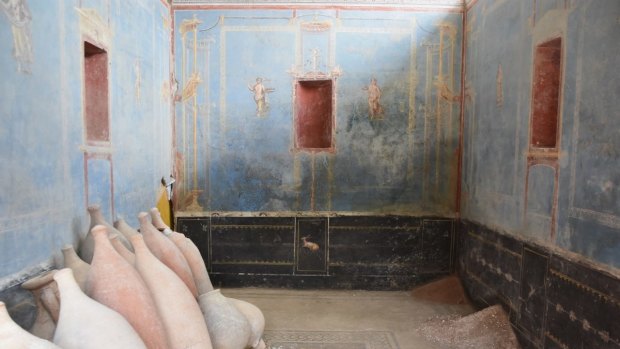This was published 5 months ago
Self-healing concrete? The Romans thought of that
By Amos Zeeberg
Rome: In June, the Italian Ministry of Culture announced the excavation of a new room, not yet open to the public, in the ruins of Pompeii. A few weeks later, a group of archaeologists gathered to marvel at it: walls covered with bright blue paint – an expensive pigment reserved for special rooms – and detailed frescoes of agricultural images remarkably well preserved after almost 2000 years.
Admir Masic, a chemist at the Massachusetts Institute of Technology, was more captivated by what appeared, to an unschooled guest, like an unremarkable pile of sandy dirt at the edge of the room. The material, light tan and granular, had been a critical component of the Roman Empire, he said: the precursor to concrete, a mainstay of Roman infrastructure, including the aqueducts that brought fresh water to cities like Pompeii.
“They managed to bring water to the city, and with water came hygiene,” Masic said. “That technological advance allowed them to, first of all, build Rome as it is, but also replicate this anywhere they would go.” He spread his arms as if circumscribing the entire Roman world.

The Pantheon in Rome has boasted the largest unsupported concrete dome in the world for 2000 years.
Modern concrete, based on a material known as Portland cement, was developed in England in the 19th century and is the world’s most popular building material by far. It is cheap, strong and standardised, providing engineers everywhere with an easy material for building apartments, dams, skyscrapers and more. But it is much less resilient than the concrete used in Roman times; over the course of decades, it develops cracks that, by letting water in, can eventually destroy the material.
Moreover, the manufacture of concrete is a major driver of climate change, producing 8 per cent of carbon dioxide emissions worldwide. By learning the secrets of Roman concrete, researchers like Masic are trying to devise greener, more durable modern options.
“Roman marine concretes have survived in one of the most aggressive environments on Earth with no maintenance at all,” said Marie Jackson, a geologist at the University of Utah.
A self-healing substance
Roman concrete derives much of its strength from a mixture of calcium aluminate silicate hydrates, known as CASH, with different chemical formulas. But exactly how the Romans produced that material is not clear.
The traditional belief is that Romans heated limestone, mostly made of calcium carbonate, to produce a dangerously reactive material called quicklime, or calcium oxide. Then they added water, forming calcium hydroxide, or slaked lime. Finally they combined this with a bulky material, often volcanic ash, which supplied the aluminum and silicon necessary for the concrete – the A and S in CASH.
Masic sees a problem with this explanation. Many examples of Roman concrete, he noted, contain visible white chunks, or clasts. “You see these everywhere – in Rome, in Africa, in Israel,” he said.

A map of a two-centimetre fragment of ancient Roman concrete (right) collected from the archaeological site of Privernum, Italy (left). A calcium-rich lime clast (in red), which is responsible for the unique self-healing properties in this ancient material, is clearly visible in the lower region of the image. Also seen are silicon (blue) and aluminum (green).Credit: MIT researchers
The chunks are typically thought to be unintentional products of poor workmanship, but Masic maintains that Roman engineers were too clever to consistently make concrete riddled with mistakes. “People said lime clasts are bad mixing of slaked lime,” he said. “Our hypothesis is it’s not part of bad processing; it’s part of the technology.”
According to Masic’s research, these lime clasts were actually reservoirs of calcium that helped fill in cracks, making the concrete self-healing. As cracks formed, water would seep in and dissolve the calcium in the lime, which then formed solid calcium carbonate, essentially creating new rock that filled in the crack.
Masic contends that the lime clasts came not from slaked lime but from quicklime that Romans added directly, a process called hot mixing. Since quicklime is so reactive, it generates heat when combined with volcanic ash, warming the material to more than 76 degrees Celsius, making the concrete harden much faster. The technique also generated some hot spots of about 200 degrees, causing some of the quicklime to remain in small, intact chunks – the clasts seen in Roman concrete today that provide its self-healing properties, Masic said.
But it’s difficult to prove the Romans intentionally left chunks of quicklime in their concrete because the chunks changed chemically over the centuries. By examining the clasts with special microscopes, Masic said, he and his colleagues have shown they indeed started out as quicklime.
Masic has spun off his research into a company called DMAT, which seeks to integrate the principles of Roman concrete chemistry into the modern version. It sells an additive that claims to seal cracks in concrete, which in theory would reduce the reliance on Portland cement, with its big carbon footprint. “We generate more strength, generate more binding agent,” said Paolo Sabatini, the company’s CEO. “When we do that, we use less concrete.”

The new room excavated in Pompeii and announced in June 2024. The room is painted blue and has been interpreted as a sacrarium, a shrine devoted to ritual activities and the storage of sacred objects.Credit: Pompeii Archaeological Park
Volcanic reactions
Not all researchers are convinced that hot mixing was the key to the Romans’ self-healing concrete. Jackson contends instead that the secret lay in the bulky materials that were mixed with lime, often a type of volcanic ash called pozzolana. Named after the seaside town of Pozzuoli, Italy, where much of it was excavated, pozzolana activated special chemical reactions that lent Roman concrete its unmatched durability, according to her research.
The initial reaction of lime and pozzolana generated the CASH compounds that acted as the glue in ancient Roman concrete. And the materials continued reacting, forming rare minerals like stratlingite for many years after the concrete was made, Jackson found. The stratlingite crystals, shaped like flakes and needles, helped bond together rough chunks of material in the concrete and blocked the growth of cracks. “This toughening of the concrete seems to be critical to the long-term resilience,” she said, and “contributes to reinforcing cohesion over the centuries.”
Jackson and her collaborators have tested their hypotheses about ancient concrete by creating modern analogues of it. In one experiment, the researchers built concrete arches, submerged them in seawater for 50 days and then pushed the top of the arches with increasing pressure until the concrete started to bend and crack. Then the arches were submerged for almost a year and tested again. The researchers found that CASH compounds had filled the tiny cracks, and that the arches could withstand two to three times as much force as before, depending on the particular test. Then the team submerged the arches once more. Later this month, they plan to test them again after almost three years in seawater.
“The way Romans chose the materials actually blocked the propagation of fractures,” Jackson said. “They were the masters.”
Jackson and her collaborators believe that they have determined exactly when the Romans achieved this mastery: in the first century BC, during the late republic. The Theatre of Marcello and Markets of Trajan – two sites in Rome that Jackson has studied – “record this breakthrough,” she said.
Warda Ashraf, a civil engineer at the University of Texas at Arlington, has developed a Roman-inspired concrete to use underwater, to build more durable bridges, breakwaters and artificial reefs while still providing as much strength as regular modern concrete.
The key innovation was using clay loaded with the mineral kaolinite, a cheap, broadly available material, to replace the volcanic ash in the ancient recipe. “We take that and use exactly the same proportions that ancient Roman engineers did,” she said.
To make the clay chemically active, they heated it to about 700 degrees. In contrast, ordinary Portland cement must be baked in a kiln at about 1400. “It’s a huge saving” in energy, she said, leading to “a 70 per cent reduction in carbon footprint.”
The researchers tested their creation in shallow water in the Gulf of Mexico. They made dozens of concrete objects – cylinders, cubes, discs – and put them in cages and then hired divers to install the cages on the seafloor about three meters down. One year later, the strength of the concrete had increased substantially, so Ashraf and her colleagues went out to celebrate. “We went to an Italian restaurant,” she said.
This article originally appeared in The New York Times.